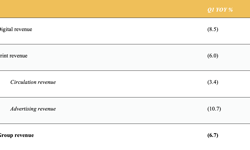Dovetail’s Subscriber Service Survey, which is now in its fourth year, polled the views of a record-breaking 150,000 active consumer magazine subscribers, making it one of the largest customer service surveys in any industry. The digital element of the survey has been growing to cover three distinct areas of digital: acquisition, customer service and the core subscription offer.
1. Digital acquisition
The start point for the whole subscription is acquisition. Our own analysis of Dovetail clients’ business shows that digital media (publishers’ own websites + online agents + email campaigns) account for over 40% of all new subscriptions generated. A significant proportion of this figure can be made up of sales which were actually driven by offline activity, but where the response mechanism was a digital one. Even so, electronic sources for print subscriptions have become massively important to the whole industry.
2. Digital customer service
When a print subscriber has a query about their subscription service, increasingly they are using electronic channels to make contact. Email now accounts for 30% of customer service contacts and self-service websites 33% of contacts as letter and phone reduce in importance.
Zooming in on self-service areas on publisher websites where consumers can manage their subscription account themselves:
* First, only 62% of all subscribers are aware that there actually is a web area they can use to manage their subscription. Although awareness is rising (it has jumped by 5% points above the levels seen in the previous year’s survey), there is still some way to go in raising the profile of this channel.
* Second, only 41% of subscribers who are aware of the site have actually used it. There still seems to be some reticence on the part of some consumers to manage their subscriptions in this way.
* Third, once a subscriber starts to use the site, their level of satisfaction with the service is very high and they use it for a number of tasks: on average 1.4 different tasks per user. Two of the most common tasks (‘Renew sub’ and ‘Check number of issues left’) relate to the renewal process where the web can be a very efficient and cost-effective tool.
The figures underline the need to promote a service which has both service and costs benefits for publisher, bureau and consumer – a true “win-win” situation for everyone. Yet the ability to cross-sell other products and services, so well developed on the phone, demands much more effort and creativity on the internet.
3. The digital subscription
This is a whole new section in the latest Subscriber Service Survey and one that we intend to expand in the future.
Penetration of eReaders
Respondents were asked, “Do you have an electronic reader on which you can read books and magazines?” The question was deliberately broad in order to capture as many devices as possible and will include tablets (eg. iPad), dedicated eReaders (eg. Kindle) as well as some smartphones. Overall, 13% of the 150,000 active magazine subscribers claim to have such a device – well above the national average. In terms of basic demographics, penetration levels are heavily skewed to men. Also, there is a bias to the 25-44 year-old age bands - eReaders are currently not youth products.
Current eReader applications
eReader owners were asked what they currently read on their device. By far the most common application is reading books (74%). Magazines lag well behind with only a 29% usage currently. This may be due in part to the type of eReader owned – for example, Kindles are great for books, but very clunky for magazines. Yet there is also a feeling that books and newspapers are able to transfer more easily from print into digital in a “print facsimile” format, whereas magazines seem to need to make more of a creative leap before digital versions can offer an appreciably better or different reading experience to the print edition.
Demand for digital magazines
All respondents were asked whether they would like an electronic version of the magazine to which they were currently subscribing (and receiving a print version). Even among eReader owners, the figure only hits 58%. Across the total sample, the figure is 25%. So, while there is demand for digital editions beyond those who currently have an eReader, it is still far from overwhelming.
Those respondents who said that they wanted an electronic version of their current magazine were then asked whether they wanted it instead of their print copy. The Digital Radicals, who wanted the digital edition instead of the print edition, made up 24%. The overwhelming 74% were Digital Conservatives, who still want the print edition as well as the digital version.
* Predictably, Computing and Men’s Lifestyle are the two sectors where the desire for a digital edition is at its strongest with figures of 39% and 38% respectively. They are also radical markets, with well above average figures for the digital-only route.
* While trade magazines come in third place in terms of digital edition potential (31%), they are by far the most radical, with a very high 43% wanting the digital edition as a print replacement.
* There are a number of sectors where the overall digital potential looks below average, but where those who do want to go digital want to make the full radical leap. Women’s Weeklies stands out in this respect – only 13% want a digital edition, but a high 41% of those want to make the leap into digital-only.
* The market with by far the lowest digital potential at the moment is Countryside and County, with only 9% wanting a digital edition.
The overseas dimension
A significant proportion of the survey respondents are overseas subscribers. They suffer many more delivery problems on their print copies and they are, understandably, very keen on digital editions – 40% of overseas subscribers want one as opposed to 23% of UK readers – yet they are very similar to their UK counterparts in wanting both digital and print.
Paying for digital magazines
All these factors flow into what subscribers are prepared to pay for their digital versions.
Of those who would actually prefer a digital edition of their magazine to the print edition, an overwhelming 79% would want to pay less for the digital version than the print version. 20% wanted to pay the same price.
Of those who would like to have a print + digital magazine bundle, only 15% are prepared to pay more for the combined package.
The implication, supported by many other research projects, is that consumers place a much lower value on digitally-delivered content than on physical print products. This has massive implications for the shape of the subscriber package of the future.
Tracking the DVD rental market
A helpful parallel is the DVD rental market. Here, Blockbuster stuck to its core retail delivery of a physical DVD product until it was too late – the company is now in Chapter 11 bankruptcy. LOVEFiLM and NetFlix developed postal delivery of a physical product and are quickly growing their streamed digital services, but as part of their established monthly subscription without reducing prices. Magazine publishers have a similar range of retail, postal and digital delivery of content and a similar legacy of consumers paying for a perceived high-value physical product. The logical conclusion is to focus on content first and to offer a range of delivery options in a bundle of parallel channels in an over-arching subscription price. To focus instead on the delivery mechanism and to try to unbundle digital from print in separate pricing packages is a dangerous road to go down as the consumer, at least for the time being, perceives digital to be a lower-cost and lower-value option than print.
Managing the magazine digital drift
A number of Dovetail clients (including such diverse titles as the Spectator, BBC Good Food and BBC Focus) are already experimenting with digital products with one option being to bundle them in as free, added-value elements of the core print subscription – something that Time Inc in the USA has recently negotiated with Apple (which, incidentally, helps to negate Apple’s reticence to share customer details with publishers).
Content is king
The publishing industry must be careful not to be misled by the early adopters who drove the initial iPad sales surge. Many of them are technophiles who are bewitched by the hardware first and are then looking for almost any content to demonstrate the functionality of their new bits of kit – this may account for the low renewal rates seen from many of the first generation iPad magazine apps. Yet most mainstream magazine subscribers seem to want their digital content as part of a bundle of editorial which is delivered through more than one channel at the same time for use in different situations – at home over breakfast (print), on the train to work (mobile or tablet), at the office desk (PC) and so on. The Economist and the FT, for example, have already made great inroads into this multi-platform offering. Digital editions might well have to be “sold” to the consumer as a free part of a content package at the moment. Yet it is conceivable that in the future, it is the print edition which could become the free, added-value element to a predominantly digitally-delivered bundle. The key is the bundle and protecting the perceived value of that bundle, not the underlying mechanics of how it is delivered which will shift in their relative importance through time. The enhanced consumer engagement with that bundle offers the potential to be monetised through additional advertising opportunities and increased subscription retention rates.
Tracking the magazine digital drift
The consumer is obviously becoming more techno-savvy in every respect. That shows in how they are recruited in the first place, how they want to manage their print subscription once they have bought one and whether they want a digital element to their core subscription package. Yet this digital shift is much more of a progressive drift than a dramatic, overnight jump. We shall be using the Subscriber Service Survey to track the “digital drift” in the future and to work closely with our publisher clients on delivering what consumers want, while leveraging as much revenue from that subscriber contact as possible.
For a copy of the full report or for more information about the Survey, contact Ranj Lall: ranj.lall@dovetailservices.com / 01795 414510










